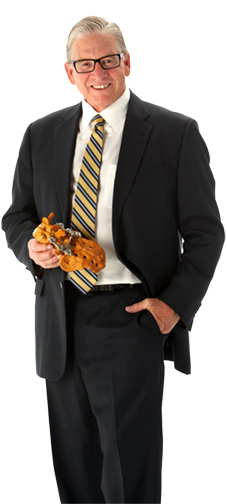 Orthopaedic Spine Surgery
Orthopaedic Spine Surgery
Atlantic Orthopaedic Specialists
When Dr. Abbott Byrd began practicing orthopaedic surgery in Hampton Roads in 1987, he was one of the few spine surgeons treating adult spinal deformity. Since the earliest days of his spinal surgery career in 1984, he has maintained a strong interest in research and innovation: that same year, with Dr. Randy Puno and Dr. Robert Winter, he developed the PWB spinal implant system to treat spinal deformity, a pedicle screw system that led to the “555” patent, describing the first variable angle pedicle screw in the world. Today, that device is on display at the Kansas University Spine and Orthopedic Historical Collections, and is credited as the first variable angled pedicle screw in the world. Dr. Byrd also invented one of the first, stand-alone, spinal cages used to treat discogenic lumbar and cervical pain. These inventions are still in use today.
A graduate of Medical College of Virginia, Dr. Byrd studied general surgery at Emory University, and completed a four-year residency in orthopaedic surgery at Duke, followed by a fellowship in spinal surgery at Minneapolis’ Twin Cities Scoliosis Center.
Dr. Byrd served as Chair of the Department of Orthopaedic Surgery at Sentara Norfolk hospitals in the 1990s, and for the last 16 years, has been the President of Atlantic Orthopaedic Specialists. During his tenure, the group has grown to include 23 physicians, supported by a staff of nearly 200 in six locations throughout South Hampton Roads. He has held leadership roles in the Scoliosis Research Society, the leading spinal deformity organization in the world. He has served as a member of the Society’s Board of Directors on two separate occasions and was recently elected Treasurer.
With his wife, Dr. Allison D. Byrd, an internal medicine physician, Dr. Byrd endowed a chair in orthopaedic surgery at Medical College of Virginia, providing funding for orthopaedic research well into the future. “Research is the key to future advances to improve the care of orthopaedic patients,” Dr. Byrd says. “Research has been the focus of my professional giving.” His philanthropy also includes leadership gifts to the Research, Education & Outreach Fund of the Scoliosis Research Society and to the Shand Circle, which was established by the Orthopedic Research and Education Foundation to provide long-term funding for independent, peer-reviewed research and education initiatives.
His contributions to treatment of these deformities are most evident in the operating room, and particularly on behalf of patients with sagittal plane deformity. As he explains, “The removal of bone (laminectomy) to decompress the nerves may weaken the spine and allow it to fall forward. Also, fusing the lumbar spine in a flattened position causes a loss of lumbar lordosis, which prevents the patient from standing erect, thus causing sagittal plane deformity. Other less frequent causes of sagittal plane deformity include fracture, infection or tumor.
“The more severe cases often require surgery to realign the spine, which usually consists of removing a portion of the spine to loosen the spine, followed by the placement of screws and rods to correct the sagittal plane deformity and restore normal lumbar lordosis. After this, the spine is fused in the corrected position to hold it permanently in place.” For the most severe deformities, Dr. Byrd performs a pedicle subtraction osteotomy, a technically demanding procedure that requires a deft hand for the delicate spine work, and mechanical expertise to realign the spine. This surgery significantly reduces pain and restores function to suffering patients.
In 2016, Dr. J. Abbott Byrd received the Virginia Orthopaedic Career Award from the Virginia Orthopaedic Society.

